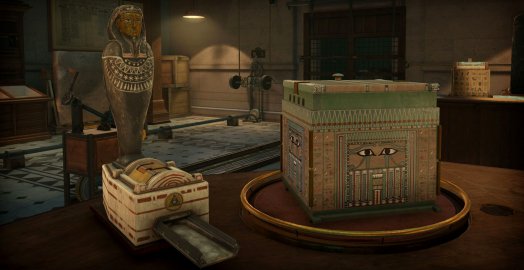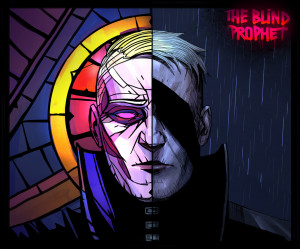Review for The Room VR: A Dark Matter

If you have been following The Room series from developer Fireproof Games, you will know it has built a well-deserved reputation for high quality and very entertaining brainteaser experiences. What started as a mobile-only experiment when The Room debuted in 2012 has since expanded with three sequels offering increased adventure elements in addition to top-notch puzzles. With The Room VR: A Dark Matter, the developers have again pushed the boundaries with a virtual reality exclusive to carry on the series legacy. So how does this latest release stack up? Very well indeed, with just a few minor issues, providing a nicely polished VR experience while staying true to the underpinnings of its predecessors.
As this is the first game in the franchise designed for VR, some basic instructions are provided in the form of a short tutorial, both before you begin and during the first few minutes of play. You are given the option of standing or sitting, making this game accessible even to those with limited mobility or a very small play area. I chose to play in standing mode, which offers a little bit more freedom of movement. Once you begin, an efficient autosave system is used that records your progress almost exactly where you left off when exiting the game or even if you accidently quit the application from within the app.
You will soon find yourself on the balcony of the Bloomsbury Police Station in downtown London, England on October 22, 1908 at 6:18 PM. What immediately struck me as being different from other VR environments is that you do not have complete freedom of movement. Rather, a node-based system using the trigger on one of the hand controllers displays a laser beam to choose where you want to move from the options available. While I understand this design choice to prevent motion sickness, I found it a bit restrictive as you cannot explore every area of the room, nor walk all the way around objects of interest, look under or over them, or climb on top of things to get a better look. At each node you have a 360-degree view using your headset, and you can move a little bit by either walking or using the triggers on the hand controllers (called a snap turn), pivoting around your position in place. On the Oculus Rift, you interact using your virtual gloves, and both hands can be used to turn, pull, push and flip switches, etc. to progress.
After activating a slide projector in the middle of the room, you’ll learn that there have been dozens of mysterious disappearances in just the last few weeks. Chief amongst them is noted archeologist Dr. Rupert Montgomery, who’s been missing for a week. The professor specializes in priceless Egyptian relics and was last seen working on a sarcophagus at the British Institute of Archeology. He told colleagues that he was on the verge of some great discovery and that he had been distracted of late. It seems that a recent argument regarding professional standards could have contributed to the incident, but no one can figure out how he could have disappeared from such a secure location.
After advancing through all the slides, you get a text message saying that you should check your desk in case the investigating sergeant left a report. You will get several subtle such messages throughout your journey that will give you a hint about what you need to do next, or how to solve a puzzle. For example, in one location you will find an organ that doesn’t work, and the message will tell you that maybe you can repair it. You can also receive ones like, “I should use my lens on that box to see if there are clues.” I appreciated these nudges in the right direction, as it suppressed my urge to immediately check the hints if I was stuck.
On your desk is a note indicating that a peculiar old gentleman was asking for you and that he left a parcel he said would help with the disappearances. The memo also states that the package was making the strangest noise, so it’s been stored in the safe for you to see for yourself. When you try to open the safe with the key, however, a mysterious black tentacle prevents it and you’re instructed to retrieve the lock pick from police lock-up instead. The game is now afoot, as this is the first of the many puzzles you will encounter that need to be solved.
When you manage to open the safe, you’ll obtain a curious artifact left for you, which triggers a flurry of weird events culminating in a new note and a strange box from your old pal The Craftsman, first encountered in The Room Three. When you solve the box puzzle and open it, you will find your trusty eyepiece with a lens which, as in previous games, is vital to your progress. From there a trail of footprints leads to another new locked box on your desk, and only after opening that are you finally able to use the artifact to transport to the Hidden Realm of the Null.
You will see that that same artifact occupies one of four spots on a table in front of you, indicating you have three more areas to explore. Sure enough, that is the case. Before all is said and done, you will have visited The British Institute of Archeology, The Chapel of the Sacred Guard (a medieval style church), a witch’s hut, and finally an ancient temple in a desert world. Each locale contains many environment-appropriate puzzles, such as a sarcophagus in the museum that must be opened, a pipe organ in the church in need of repair, potion mixing in a cauldron in the witch’s hut, and an ancient temple to explore in the desert world, where you will solve the final puzzle of the game.
As with the previous games, The Room VR excels with well-designed, multi-part challenges that are fun to tackle and satisfying when solved. Most of the methods for doing so are the same as before, including an inventory that can hold up to five items along with your multi-purpose lens, easily accessed with a button press on one controller and selecting things with the other. One feature I really liked in the earlier titles was the ability to manipulate inventory items into something new. Sadly, in this release there is only one such object and I wished more items were of this type.
The standard lens is used to reveal secret drawings and writings on the floor, walls and ceiling, so you need to activate it to check each new location to see what is hidden from the naked eye. This is extremely important both to discover clues and grant you access to areas not otherwise available. The lens is also required to solve some mostly mechanical riddles whose areas shimmer to let you know of their hidden presence.
Once you acquire a new special lens, you will also be able shrink down to explore and manipulate items from inside (the same as in The Room Three, but visually stunning in VR). This is done in conjunction with external manipulations to solve many of the puzzles. Finally, you’ll use this lens on specific notes you find to see a hole in the middle; you must then align the hole with another element for a brief cut-scene that will either reveal a clue, add an object needed to solve the area, or transport you to a new location.
A welcome new aspect is the clever use of the VR environment. Many puzzles are solved in ways that would be difficult or cumbersome with a keyboard and mouse. You will need to pull levers, rotate tables, poke, prod, grab and turn things to see what happens and figure out what to do. The developers have done an excellent job of exploiting this technology, adding a whole new level of immersion. I do have a gripe about one design decision, though: several puzzles are solved by back and forth trips inside and outside a given object, which gets a bit tedious. One in particular requires that you solve a variation of a stained glass puzzle five different times. While the tasks required to reveal the next colour combination change from one occasion to the next, the way combinations are actually matched remains pretty much the same and becomes quite tedious.
The hint system returns, though in VR you need to “pull” on a question mark to access it. Three hints are provided, with each successive layer giving more detail while a timer makes you wait for the next clue in the sequence. I had to seek help for a handful of puzzles, as I found them pretty tough. Having said that, I was usually able to solve the current problem by revealing just the first hint. Only twice did I need to look at all three. All told, it took me about six hours to complete the game.
A Dark Matter is stunning graphically, assuming you have the necessary hardware to support the highest resolution available. Everything you see is clean and crisp with a lot of attention to detail. Everywhere you go you will find things like scattered pages on the floor, notes, diagrams, pictures, hieroglyphics and stone tablets. I was particularly impressed whenever the special lens revealed small floating crystals in front of an opening to one of the puzzle areas, such as the main box in the church. In spots like this, reducing yourself to a shrunken state places you on one of these crystals to look around, literally floating in space as you admire the now-enlarged details of the surrounding area. It is breathtaking! I’ve stood on a glass window of the CN Tower in Toronto and looked down, and I experienced the same awestruck sensation here. There are also subtle animations, such as tapestries hanging from the church ceiling rustling gently in a slight breeze. This greatly adds to the atmosphere and the sense of actually being there personally in the 3D space.
The soundscape is equally impressive, with realistic effects in every area, whether it’s ropes being pulled, cranks being turned, bells ringing, organs playing, or drawers opening. There are also game-specific sounds that occur when you travel to a new node, use your lens, collect and use an inventory item, and many others. There is almost no music other than the familiar opening menu tune from the other games. The rare times you do hear music add some welcome drama, such as when you open the lid of the sarcophagus in the museum. As this game is very much a lonely endeavour, and you never know what may lie around the next corner, I applaud the restraint used to allow for a quietly eerie environment, even if you’re never really in any danger.
The plot is advanced once again through a series of notes and messages discovered along the way, both from The Craftsman and from other unnamed characters in pursuit of “the artefact” you possess. While the storyline is a familiar one that carries on from previous installments, and it’s once again intriguing enough to want to learn more, in this case I found it difficult to follow. It appears that the missing people are being used by The Craftsman to bring the arcane forces at work under his control, and you are being pressured to help. There is also mention of “the watcher,” but it is not clear who that is or what role they play. Without giving away the ending, it does not match the various story elements you uncover leading up to that point, and it left me just scratching my head.
Despite a few minor issues and some ongoing narrative ambiguity, The Room VR is a worthy addition to this stellar series of puzzle games, and I highly recommend it to anyone who is fond of puzzles and has the required hardware to play it. While there are fewer pure adventure elements this time around, their omission is more than compensated for by the increased immersion of experiencing it in virtual reality. I am not sure if Fireproof Games is planning any more VR-based games, but A Dark Matter is an excellent first foray into this new technology, and I hope it won’t be the last.































